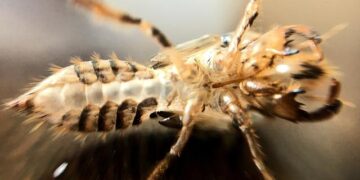A few miles off the highway in Hempstead, Long Island, on a gently curving street of tidy two-story homes and raked lawns, there is a sprawling ranch house with a back yard, a pool, and a large, netted enclosure, like an aviary, built to house seventeen cats. But when I drove there, on a bright, chilly fall day, I had not come to see the cats. I pulled in to the driveway, a screen door opened, and two small white dogs emerged, attached by harnesses and long leashes to John Mendola, a retired police officer in his fifties with a mild manner and a broad, kind face. (The house is his mother’s; he lives in a smaller place nearby.) He introduced me to the dogs, Princess Ariel and Princess Jasmine. They were named for a deceased, much mourned dog named Princess—part Shih Tzu, part Lhasa Apso—whom they strongly resemble. As they should: they are Princess’s clones.
Mendola took me inside and sat on a sofa, a new Princess on each side, while he told me about their forebear, a stray who was brought into the police precinct when he was on duty one day in 2006. “We had animals my whole life,” he said. “I never had one that was so affectionate. She’d look at me and give me that soulful eye.” He gave a sigh of satisfaction. “It was a special bond.” As he spoke, he reached out and stroked Princess Jasmine reflexively.
In 2016, the original Princess was given a diagnosis of cancer, and Mendola was devastated. He had seen a television program about pet cloning, and, looking online, he found a company in Texas called ViaGen Pets & Equine. ViaGen could cryogenically preserve a pet’s cells indefinitely and generate a new pet from the old cells, for a fee of fifty thousand dollars. Mendola sent off for one of ViaGen’s biopsy kits, and, when Princess had surgery to remove a cancerous mass, he asked the vet to take a tissue sample, which he sent to the company.
Princess died in March, 2017, but Mendola spent months grieving before he made up his mind to go ahead with cloning her. Once he had made the decision, after ViaGen advertised a twenty-per-cent discount, he travelled to a suburb of Austin to visit ViaGen’s genetic-preservation site. “I saw the facility,” he said. “I have a picture of it, and a little video of where the liquid nitrogen is.” Standing outside the building where Princess’s cells were cryopreserved, he said to himself, “They’re in there. Your little ones are in there.”
Mendola placed his order with ViaGen on the first anniversary of Princess’s death. Eight months later, he went to LaGuardia Airport to meet the two resultant puppies. In a video taken of their meeting, Mendola starts tearing up as he grabs hold of them. “Are you my little Princesses?” he coos. Two months old, they squirm in his grip.
The little Princesses, now five, fussed as Mendola stroked them and tried to hold them in place. As they moved, they were indistinguishable: small bundles of soft fur, trimmed close. When they sat still for a treat, I could see that they had similar, though not identical, golden markings on their bodies. And, like the original Princess, each has one misaligned eye—a different eye in each clone, so that they look like mirror images of each other.
Cartoon by Edward Koren
It has now been nearly thirty years since cloning mammals became possible. The technology has mainly been used to produce cattle, sheep, and pigs. The F.D.A. has signed off on the use of cloned farm animals as meat, although most agricultural clones are used for breeding. Meanwhile, since 2005, more than two thousand dogs have been successfully cloned. Biologically, their genesis is not very different from that of cloned cows or sheep, but in other respects the cloning of pets is far more uncanny.
The domestic dog, Canis familiaris, is seen by most owners as a species of individuals, with distinct personalities and quirks. I am a scientist who studies dog behavior and cognition, and the pet dogs who participate in my studies all bring their own idiosyncrasies with them. Early in the domestication of the species, dogs were presumably kept for functional roles—guard, hunter, herder—but in contemporary society they are kept for companionship. As a result, we have projected our ideas of selfhood onto them, giving them biographies, preferences, fears, plans, and moods.
But, if it is dogs’ individuality that we value, what should we make of the idea that their unique and unreproducible selves can, in fact, be reproduced? Cloning is the ultimate expression of genetic determinism—chromosomes as character. ViaGen’s Web site declares that a cloned dog “is simply a genetic twin of your dog, born at a later date.” The assertion is not untrue, as far as it goes, but it’s a sales pitch that dodges a host of complicated ethical and identity issues. There are issues of exploitation—both of the bereaved owners whose desire to somehow cheat death is being monetized and, more viscerally, of the unseen animals whose bodies are used in making a clone. There’s the issue of supply: the production of bespoke dogs in a society when so many good, naturally born ones in shelters are in need of adoption. Finally, there’s an existential issue: who, exactly, is produced when a dog is cloned?
The business of cloning is an outgrowth of the discovery of genomic equivalence, the fact that the DNA sequence is identical in all the cell types of our body. Evidence for genomic equivalence began to accumulate in the mid-twentieth century, and, in 1962, the British biologist John Gurdon succeeded in growing adult African clawed frogs from the intestinal cells of tadpoles, work for which he later won the Nobel Prize in Medicine. In 1996, a sheep called Dolly became the first mammal clone to be born. Dolly was euthanized in 2003, at the age of six, after veterinarians found tumors in her lungs, but she was preserved in taxidermied form at the National Museum of Scotland and also had offspring of her own, fathered the old-fashioned way, by a ram named David.
In 2005, researchers at Seoul National University, in South Korea, took an ear-skin sample from an Afghan hound named Tai and made two dogs: Snuppy (a portmanteau of “Seoul National University” and “puppy”) and another, unnamed twin, who died after twenty-two days. Snuppy lived for ten years, all of them in a laboratory. At the age of five, he was himself cloned: four re-Snuppys were born, of whom three survived. Since Snuppy’s birth, dog cloning has joined the cloning of livestock as a retail business. All told, more than a dozen mammalian species have been cloned, including macaques, red deer, cats, and water buffalo. Hwang Woo-suk, who led the team that cloned Snuppy, now clones camels raised for racing and for mazayna (a kind of camelid Westminster Dog Show) in Abu Dhabi.
Like Dolly and Snuppy, all clones are conceived through somatic-cell nuclear transfer: the nucleus of a skin cell from one animal is extracted and implanted into an egg whose nucleus has been removed. The transplanted nucleus contains all the instructions needed to make the new organism. At ViaGen’s genetic-preservation site, the building near Austin that Mendola had stood expectantly outside, I met with the company’s cell-culture manager, Sanaz Arenivas, who told me that she recommends that people send a sample of skin cells around the size of half a pencil eraser, but sometimes people just send in a whole ear from their dead dog. “Time is of the essence in a post-mortem situation,” ViaGen’s Web site warns grieving (or pre-grieving) owners.
Often, the samples arrive at ViaGen accompanied by photographs and stories about the dogs from whom they came. Arenivas showed me the lab where she isolates the cells from the samples, after which she puts the cells in a petri dish with a growth medium until there are about a million of them. With a cryopreservant added, each of these cell lines is then kept chilled, by liquid nitrogen, at minus a hundred and fifty degrees Fahrenheit, in large silver tanks. Arenivas put on insulated gloves and safety glasses and opened the top of one of the tanks for me. Clouds of vapor escaped as she reached in and pulled out a rack of vials, like a core sample from a sulfurous spring. The tanks house up to fifty thousand vials of cells. Each sample has a unique identifying number—“like V100-Buddy,” she told me. “We have a lot of Buddys.”
When it comes to actual cloning, each attempt requires making use of two other dogs. The first of these, the donor, provides developing eggs, known as oocytes. A dog in estrus is operated on to extract these oocytes. Then, under a microscope, the nucleus of an oocyte is sucked out with a tiny pipette and replaced with the nucleus from a skin cell of the dog who’s being cloned. Electricity is used to stimulate cell division, and, when this embryo is still just a bundle of cells on the scale of micrometres, a second dog, also in estrus, is operated on to become a surrogate mother. Her ovaries are pulled outside her body, and a catheter full of embryos is plunged into her oviduct. Typically, the surrogate receives multiple embryos from several different cell lines. Many of these embryos will die; those that survive live in her uterus for the usual canine gestation period, around sixty days, after which, with any luck, a pup is born.
ViaGen is the only business in the U.S. that clones dogs, and its cloning process is patented. A few months ago, I drove to visit its president, Blake Russell, who lives on a hundred-acre ranch ninety minutes north of Dallas. As the buildings lining the interstate got smaller and the scrubby forest grew denser, I noticed a dead armadillo on its back, legs splayed. I wondered if this unfortunate creature might be a nine-banded armadillo, a local species that gives birth to four genetically identical young—almost like clones of one another.
A tall man wearing a blue Baja hoodie and a day’s worth of stubble, Russell had to crouch to see me in my compact rental car, but he was talking even before I rolled down my window. “That’s Beatrice,” he explained, as a long trailer pulled by a pickup slowly rolled by, emitting a series of whinnies. Beatrice was a surrogate horse, and she was with her foal, a two-month-old clone.
Russell joined ViaGen in 2005. At the time, the company cloned many farm animals, but the agricultural business, which produces cattle, sheep, and pigs, is now separate from the pet-cloning side, which produces dogs, horses, and cats. Oddly, for the head of a company that has cloned hundreds of dogs, Russell said that he is “not a dog person.” As a child, he was mauled by a German shepherd and needed a large number of stitches in his face. Still, he owns two ranch dogs, including Lucy, a large hound mix. Before he adopted her, she was the surrogate mother to a litter of wolf-dog hybrid clones.
“Listen, I know you’re both worried that I haven’t made any friends, but it will really pay off in twenty to twenty-five years, when I’ll be spared from having to attend a wedding every weekend.”
Cartoon by Natalya Lobanova
Russell—a third-generation horseman, as he told me several times—is much more hands-on when it comes to cloning horses. The ranch is home to a couple of hundred mares—many pregnant—and a few dozen foals. Most of these are the company’s, not Russell’s, but he has gene-banked his father’s favorite horse, Chief Comanche, and plans to revive him for his presumed future grandkids. He led me to a heated stall with two newborn foals: a day-old quarter horse, his head fuzzy and tail short, and another, born prematurely without a suckle reflex, who had a tube inserted from his nose to his stomach. Later, Russell escorted me to the horse-cloning facility, a two-room office in a tiny cluster of low-rise buildings a short drive from his ranch. The site’s embryologist led me past a small fridge labelled “oocytes,” then gestured toward a cluster of large boxes where the embryos were developing. “These are our incubators,” she told me, unwittingly quoting a line from “Brave New World” nearly word for word.
>>> Read full article>>>
Copyright for syndicated content belongs to the linked Source : The New Yorker – https://www.newyorker.com/magazine/2024/07/01/would-you-clone-your-dog































